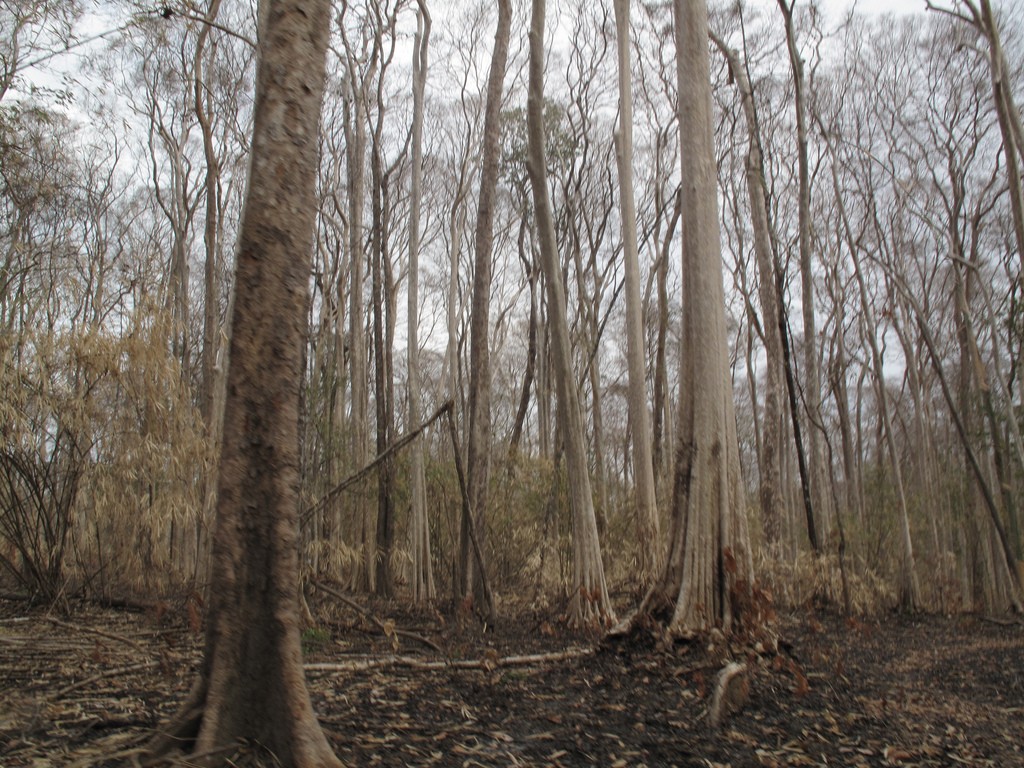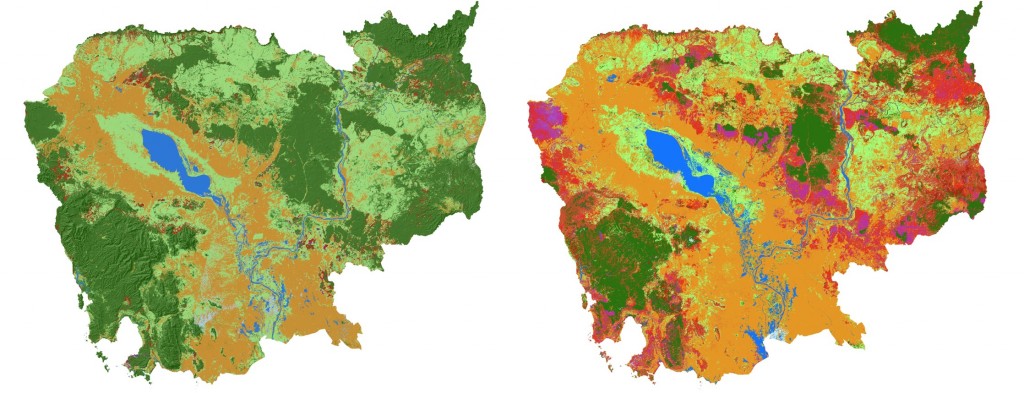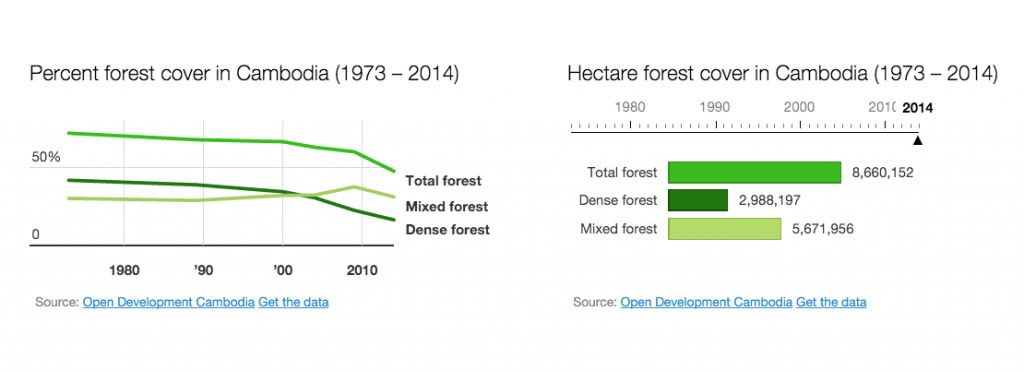
ព្រៃឈើនៅកម្ពុជា។ រូបភាព ថតដោយ វិទ្យាស្ថានអន្តរជាតិសម្រាប់បរិស្ថាន និងការអភិវឌ្ឍ, ១២ មេសា ២០១០។ ក្រោមអាជ្ញាប័ណ្ណ CC BY-NC 2.0។
គម្របព្រៃឈើ គឺជាតំបន់ដែលមានដីគ្របដណ្តប់ ដោយគម្របដើមឈើ (ឬ កាណូភី)។ ការវាស់ស្ទង់ និងការរាយការណ៍គម្របព្រៃឈើនេះ អាចបង្ហាញពីប្រភេទផ្សេងៗគ្នានៃព្រៃឈើដែលមាន និងតំបន់នីមួយៗ និងថាតើតំបន់ទាំងនោះ មានការផ្លាស់ប្តូរយ៉ាងដូចម្តេចក្នុងរយៈកាលកន្លងមក។ នៅប្រទេសកម្ពុជា ការធ្វើរបាយការណ៍គម្របព្រៃឈើ បានធ្វើបរិមាណវិស័យពីទំហំនៃការកាប់បំផ្លាញព្រៃឈើ ដែលបានកើតឡើងនៅក្នុងរយៈពេលបួនទសវត្សរ៍ចុងក្រោយមកនេះ។
មានអង្គការមួយចំនួន បានរាយការណ៍អំពីគម្របព្រៃឈើ ដែលទាក់ទង ឬ រាប់បញ្ចូលទាំងប្រទេសកម្ពុជា រួមមាន អង្គការទិន្នន័យអំពីការអភិវឌ្ឍ ក្រុមអ្នកស្រាវជ្រាវនៃសាកលវិទ្យាល័យម៉ារីលែន និងស្ថាប័នដទៃទៀត។
ក្នុងឆ្នាំ២០០៦ រដ្ឋបាលព្រៃឈើនៃប្រទេសកម្ពុជា បានបោះពុម្ពផ្សាយផែនទីមួយ ដែលបង្ហាញពីគម្របព្រៃឈើនៃប្រទេសកម្ពុជាឆ្នាំ២០០២។ បន្ទាប់មកនៅឆ្នាំ ២០១១ រដ្ឋបាលព្រៃឈើ ដែលទទួលបានការគាំទ្រពីអង្គការឈើតំបន់ត្រូពិចអន្តរជាតិ និងរដ្ឋាភិបាលនៃប្រទេសដាណឺម៉ាក បានបោះពុម្ពផ្សាយគម្របព្រៃឈើនៅប្រទេសកម្ពុជា ឆ្នាំ២០១០ ដែលរួមមានផែនទីនៃការផ្លាស់ប្តូរគម្របព្រៃឈើរវាងឆ្នាំ២០០៦ និង២០១០ និងរវាងឆ្នាំ២០០២ និង២០១០។1
រហូតមកទល់ពេលបច្ចុប្បន្ន ដោយសារមិនមានការបោះពុម្ពផ្សាយផែនទីផ្លូវការ ឬ ការវិភាគជាក់លាក់ពាក់ព័ន្ធទៅនឹងប្រទេសកម្ពុជា អង្គការទិន្នន័យអំពីការអភិវឌ្ឍ បានសម្រេចបង្កើតសំណុំបច្ចុប្បន្នភាពផែនទីគម្របព្រៃឈើ។ ផែនទីគម្របព្រៃឈើសម្រាប់ឆ្នាំនីមួយៗ ត្រូវបានធ្វើឡើងពីរូបភាពផ្កាយរណបក្នុងចន្លោះពី ១៦ ទៅ ១៩ផ្ទាំង ដែលបានយកមកពីទីភ្នាក់ងារស្រាវជ្រាវភូគព្ភសាស្ត្ររបស់សហរដ្ឋអាមេរិច (USGS)។ រូបភាពទាំងនេះជារូបភាពដាក់ឱ្យប្រើប្រាស់ជាសាធារណៈដោយមិនគិតកម្រៃ ហើយអាចទាញយកបានពីគេហទំព័របស់ភ្នាក់ងារស្រាវជ្រាវភូគព្ភសាស្ត្ររបស់សហរដ្ឋអាមេរិច (USGS)។ អង្គការទិន្នន័យអំពីការអភិវឌ្ឍ បានជ្រើសរើសរូបភាពផ្កាយរណបសម្រាប់ការវិភាគក្នុងឆ្នាំ ១៩៧៣, ១៩៨៩, ២០០០, ២០០៩, និង ២០១៤ ដោយអាស្រ័យទៅលើគុណភាពនៃរូបភាពទាំងនោះ ជាពិសេសរូបភាពដែលអវត្តមានគម្របពពក។
ផែនទីមុនឆ្នាំ២០១៤ រាប់បញ្ចូលដំណាំទៅក្នុងចំណាត់ថ្នាក់នៃព្រៃល្បោះ និងព្រៃស្រោង ដោយសារមានផលលំបាកក្នុងការញែកចំការដំណាំពីព្រៃ បើយោងទៅតាមភាពច្បាស់លាស់នៃរូបភាពដែលមាន។ ជាផ្នែកមួយនៃការត្រៀមរៀបចំរបស់ក្រុមការងារសម្រាប់ការវិភាគឆ្នាំ២០១៤ អ្នកជំនាញផែនទីបានប្រើប្រាស់រូបភាពដែលមានកម្រិតភាពច្បាស់ខ្ពស់ ដើម្បីបញ្ជាក់ពីវត្តមាននៃស្តង់ដាររួមមួយសម្រាប់ដំណាំ និងចំការកៅស៊ូ។ វិធីសាស្ត្រនេះ ត្រូវបានយកមកប្រើជាមួយនឹងតំបន់ដែលមានចំការ (ដូចជាចំការដែលត្រូវបានរដ្ឋាភិបាលកំណត់សម្រាប់សម្បទានដីសេដ្ឋកិច្ច)។ ការអនុវត្តវិធីសាស្ត្រនេះ នាំឱ្យការបង្ហាញព័ត៌មានស្តីពីព្រៃស្រោង ឆ្នាំ២០១៤ កាន់តែច្បាស់ជាងមុន។
អង្គការទិន្នន័យអំពីការអភិវឌ្ឍ បានបោះពុម្ពរបាយការណ៍នេះជាលើកដំបូង នៅក្នុងឆ្នាំ២០១៣។ បន្ទាប់ពីទទួលបាន ការផ្តល់មតិកែលម្អ និងការពិភាក្សាមួយចំនួន ជាមួយអ្នកជំនាញ និងស្ថាប័នផ្សេងៗទៀត រួមមានរដ្ឋបាលព្រៃឈើ។ ផែនទីដែលកែលម្អ ត្រូវបានបង្កើតក្នុងឆ្នាំ២០១៤ និងបោះពុម្ពផ្សាយនៅដើមឆ្នាំ២០១៥។ អានបន្ត … |
អង្គការមូលនិធិពិភពលោកសម្រាប់ធម្មជាតិ (WWF) អង្គការអភិរក្សសត្វព្រៃ (WCS) និងអង្គការឃ្លាំមើលព្រៃឈើសកល (GFW) ក៏បានផ្តល់មតិយោបល់នៅដំណាក់កាលផ្សេងគ្នានៃគម្រោងរបស់អូឌីស៊ីផងដែរ។
សាកលវិទ្យាល័យម៉ារីលែន
អ្នកស្រាវជ្រាវនៅសាកលវិទ្យាល័យម៉ារីលែន បានគូសផែនទីអំពីវិសាលភាព ការបាត់បង់ ការកើនឡើង នៃគម្របដើមឈើ នៅទូទាំងពិភពលោក ចាប់ពីចន្លោះឆ្នាំ ២០០០ ដល់ ២០១២។2 លទ្ធផលនេះ បានផ្អែកទៅលើការវិភាគនៃរូបភាពតាមផ្កាយរណប។
ដើមឈើ ត្រូវបានកំណត់ថាជារុក្ខជាតិដែលមានកំពស់ខ្ពស់ជាង ៥ ម៉ែត្រ។ ចំពោះ “ការបាត់បង់គម្របព្រៃឈើ” ត្រូវបានកំណត់ថាជាការផ្លាស់ប្តូរពីភាពមានព្រៃទៅជាគ្មានព្រៃ ក្នុងអំឡុងឆ្នាំ ២០០០ ដល់ ២០១៣។ រីឯ “ការកើនឡើងនៃគម្របព្រៃឈើ” ត្រូវបានកំណត់ថាជា ភាពផ្ទុយគ្នានៃការបាត់បង់ព្រៃឈើឬភាពគ្មានព្រៃឈើ ចំពោះការផ្លាស់ប្តូរព្រៃឈើទាំងស្រុង ក្នុងអំឡុងឆ្នាំ ២០០០ ដល់ ២០១២។
កំណែនៃផែនទីអន្តរកម្មរួមជាមួយនឹងមុខងារមួយចំនួន អាចរកបានជាសាធារណៈ។ ផែនទីដែលផ្អែកលើការសិក្សារបស់សាកលវិទ្យាល័យម៉ារីលែន អាចរកបាននៅក្នុងគេហទំព័ររបស់អង្គការឃ្លាំមើលព្រៃឈើជាសកល។3
អង្គការមូលនិធិពិភពលោកសម្រាប់ធម្មជាតិ (WWF)
អង្គការមូលនិធិពិភពលោកសម្រាប់ធម្មជាតិ (WWF) មានផែនទីដែលបង្ហាញពីព្រៃឈើនៅក្នុងតំបន់ត្រូពិចនៅឆ្នាំ២០០០ និងបានប៉ាន់ប្រមាណគម្របព្រៃឈើនៅឆ្នាំ២១០០ ជាមួួយការបន្តការបំផ្លាញព្រៃឈើ នៅក្នុងអត្រាដូចបច្ចុប្បន្ន។4
អង្គការនិន្នាការព្រៃឈើ (Forest Trends)
ក្រុមការពារបរិស្ថានមានមូលដ្ឋាននៅអាមេរិក ក៏បានរាយការណ៍ពី គម្របព្រៃឈើកម្ពុជាក្នុងឆ្នាំ២០១៥ ផងដែរ។5 អង្គការនេះ បានរកឃើញថាសម្បទានដីសម្រាប់ការធ្វើកសិកម្មខ្នាតធំ ដែលភាគច្រើនបានផ្តល់ទៅឱ្យក្រុមហ៊ុនមកពីកម្ពុជា ចិន និងវៀតណាម បានធ្វើអោយគម្របព្រៃឈើរបស់ប្រទេសកម្ពុជា មានការថយចុះ។
យោងតាមរបាយការណ៍នេះ រដ្ឋាភិបាលកម្ពុជា បានផ្តល់សម្បទានដីសរុបចំនួន ២៧២ គិតត្រឹមចុងឆ្នាំ ២០១៣។ ជាង ៨០ ភាគរយ ស្ថិតនៅក្នុងដីព្រៃ និង ១ភាគ៤ ស្ថិតនៅក្នុងព្រំដែនតំបន់ការពារ។
គ្រោះថ្នាក់ជុំវិញការរាយការណ៍
ការរាយការណ៍លើបញ្ហាព្រៃឈើទាំងនេះ អាចបង្កឱ្យមានគ្រោះថ្នាក់យ៉ាងខ្លាំង។ នៅក្នុងខែវិច្ឆិកា ឆ្នាំ២០១៥ អង្គការអន្តរជាតិ អ្នកកាសែតគ្មានព្រំដែន បានចេញរបាយការណ៍មួយមានចំណងជើងថា បរិយាកាសមិនអនុគ្រោះសម្រាប់អ្នកកាសែតបរិស្ថាននោះទេ។ របាយការណ៍នេះ បានបង្ហាញថាប្រទេសកម្ពុជា និងឥណ្ឌា ជាប្រទេសដែល “មានមនុស្សបាត់បង់ជីវិតច្រើន” ចំពោះការរាយការណ៍ពីវិស័យបរិស្ថាន ដោយរបាយការណ៍នេះ បានចង្អុលបង្ហាញថា អ្នកកាសែតបរិស្ថាន ៤នាក់ ត្រូវបានសម្លាប់នៅក្នុងប្រទេសកម្ពុជា ពីឆ្នាំ ២០១២ ដល់ឆ្នាំ ២០១៤។6 ក្នុងចំណោមនោះ អ្នកកាសែត ៣នាក់ រាយការណ៍ពីការកាប់បំផ្លាញព្រៃឈើ និង ការកាប់ឈើខុសច្បាប់។
ធ្វើបច្ចុប្បន្នភាពចុងក្រោយ៖ ថ្ងៃទី១៨ ខែមករា ឆ្នាំ២០១៦
ទាក់ទងនឹងការធ្វើរបាយការណ៍គម្របព្រៃឈើ
- ការសិក្សាអំពីគម្របព្រៃឈើ (១៩៧៣-២០១៤) ផលិតដោយអូឌីស៊ី
- វាក្យសព្ទ និងនិយមន័យ ព្រៃឈើ
- បរិស្ថាន និងធនធានធម្មជាតិ
ឯកសារយោង
- 1. រដ្ឋបាលព្រៃឈើ, ក្រសួង កសិកម្ម រុក្ខាប្រមាញ់ និងនេសាទ. (២០១១). គម្របព្រៃឈើកម្ពុជា ឆ្នាំ២០១០. http://www.twgfr.org/itto/wp-content/uploads/2012/06/Cambodia-Forest-Cover-2010_KH.pdf ដកស្រង់ ៣១ មិនា ២០១៥.
- 2. ហាន់សេន និងក្រុមការងារ “កម្រិតភាពច្បាស់នៃផែនទីសកល នៃការផ្លាស់ប្តូរគម្របព្រៃឈើក្នុងសតវត្សរ៍ទី២១”, វិទ្យាសាស្ត្រ, ១៥ វិច្ឆិកា ២០១៣: វ៉ុល ៣៤២, លេខ ៦១៦០, ទំព័រ ៨៥០–៨៥៣ http://earthenginepartners.appspot.com/science-2013-global-forest
- 3. http://www.globalforestwatch.org/country/ (KHM) ដកស្រង់ ២៣ កក្កដា ២០១៥។
- 4. http://wwf.panda.org/about_our_earth/deforestation/forest_publications_news_and_reports/living_forests_report/ ដកស្រង់ ២៣ កក្កដា ២០១៥។
- 5. អង្គការនិន្នាការព្រៃឈើ ឆ្នាំ២០១៥. ការបម្លែងឈើ ការតាមដានព្រៃឈើ និងអភិបាលកិច្ចនៃការប្រើប្រាស់ដី នៅកម្ពុជា, កក្កដា ២០១៥.http://forest-trends.org/releases/uploads/Cambodia%20Concessions%20Report%20small%20size.pdf
- 6. អង្គការអ្នកកាសែតគ្មានព្រំដែន. ២០១៥. បរិយាកាសមិនអនុគ្រោះសម្រាប់អ្នកកាសែតបរិស្ថាន. http://en.rsf.org/environmental-journalism-in-an-26-11-2015,48582.html ដកស្រង់ ២៨ វិច្ឆិកា ២០១៥.



